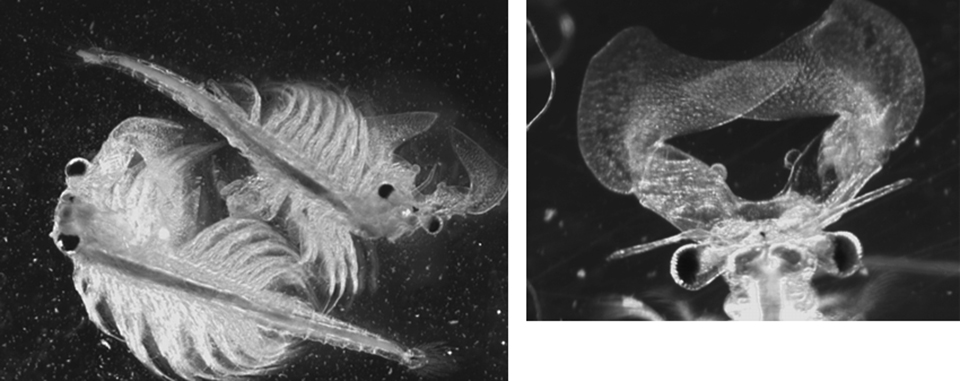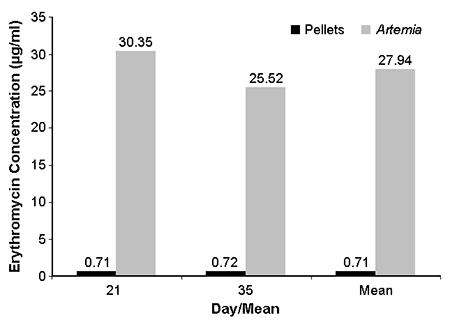Palatability and digestibility tested at NFSC

In response to the decline of several populations of Pacific salmon (Oncorhynchus sp.), captive broodstock programs have been established to protect and rebuild wild stocks. Unfortunately, bacterial kidney disease (BKD) has become problematic for these programs.
The causative agent of BKD, Renibacterium salmoninarum, can be transmitted from fish to fish and from female to progeny. Even though treatment with the antibiotic eryth-romycin can reduce symptoms, chronic infection often results in death and a loss of genetic material.
In conjunction with broodstock injection and egg disinfection, treatment of first-feeding salmonids may help break the mother-to-fry transmission of BKD. However, a palatable and controlled method of administering erythromycin to first-feeding fry is needed. Adult artemia, bioencapsulated with erythromycin, may provide an alternative to treatment with medicated pelleted diets.
Artemia
Artemia nauplii are a standard and often mandatory feed for cultured marine fish larvae. Adult artemia are also sometimes used before fish are weaned onto a formulated diet. They are very palatable to fish larvae and juveniles, so adult artemia could be an effective therapeutant delivery system for young salmonids, as well as other difficult-to-treat aquatic organisms.
Palatability
Adult artemia are not traditional feed items for cultured fish. However, results from trials at the Northwest Fisheries Science Center (NFSC) in Seattle, Washington, USA showed that adult artemia are highly palatable to first-feeding coho fry and young lingcod.
Increased consumption due to palatability provided artemia-fed fry with a weight advantage over coho fry fed pellets. This weight advantage continued after the fry fed adult artemia were switched to pellets. The palatable nature of adult artemia may also be a benefit when treating larvae and juveniles brought in from the wild.
Bioencapsulation
Bioencapsulation is an easy step that fits into preexisting on-site live food production for marine fishes. Using a simple bioencapsulation technique, NFSC obtained concentrations of about 100 µg erythromycin/wet grams of adult artemia (Fig. 1). This was done by adding 1 gram of erythromycin and 25 grams of live artemia to a 1-liter cone of salt water. The solution was then vigorously aerated for 10 to 14 hours. Although higher concentrations could be achieved with a larger dose of erythromycin, artemia survival was compromised.
Further trials showed large differences in bioencapsulation concentration and artemia survival, depending on the form of erythromycin used and artemia source. The greatest success came from bioencapsulating cultured adult artemia with erythromycin stearate or phosphate. Similar results have been obtained with Romet® and azithromycin, so other therapeutants could be used for other pathogens.
Processing
A concern in feeding live or processed artemia is the possible transfer of pathogens resident in the artemia. This can be reduced by producing artemia on site, using prophylactic techniques, or purchasing cultured artemia. In pilot trials, adult artemia withstood immersion in 50 percent ethanol and diluted chlorine bleach long enough for disinfection of surface bacteria. Further research is needed to determine if these procedures are sufficient to completely sterilize artemia. Ultraviolet light and ozone may be good additional techniques for sterilization.
Once artemia are shown to be pathogen-free, they can be bioencapsulated and fed out. Feeding artemia live is ideal, but may not always be possible, due to sporadic availability and the infrastructure needed for bioencapsulation. Bioencapsulated artemia can be freeze-dried and fed as a dry product. Bioencapsulated artemia can also be frozen, although this lowers performance since frozen artemia sink quickly and disintegrate as they fall through the water column.
Digestibility
Understanding the bioavailability of chemotherapeutants is important for maximum absorption of these compounds with limited waste. Bioavailability varies depending on the ingredients in the feed and the way the feed is prepared.
Uptake of erythromycin from pellets and artemia may also be influenced by feed composition and preparation. In an apparent digestibility trial using 100-gram sockeye salmon, significantly more erythromycin was taken up from freeze-dried adult bioencapsulated artemia (98.3 percent) than from pellets containing erythromycin (89.2 percent).
Feeding trials

Two feeding trials were conducted to investigate the transfer of erythromycin from feeds to first-feeding sockeye salmon fry. The first trial investigated erythromycin uptake between live bioencapsulated adult artemia and a nutritionally similar pelleted diet. In the second trial, erythromycin uptake from a pelleted diet top-dressed with erythromycin, live bioencapsulated adult artemia, and freeze-dried bioencapsulated adult artemia was determined.
In trial 1, significantly greater amounts of erythromycin were taken up by fish fed live artemia (Fig. 2). Trial 2 determined that erythromycin uptake from live and freeze-dried artemia was similar. In both trials, bioencapsulated artemia were better at delivering erythromycin than pellets.
Both live and freeze-dried artemia feeds were neutrally buoyant and visible to the fry. The organisms were more quickly and completely consumed than the pellets used in our study. Some pellets were pulled quickly to the tank sides by surface tension or the current, while the remaining pellets sank quickly, giving fry less time to consume them.
Feeding rates
First-feeding sockeye accepted pellets and grew at a rate equal to that of fish fed artemia. However, the fish quickly lost interest in the medicated pellets, and 12 to 16 feedings per day were required to complete a daily ration. Very careful feeding was necessary to minimize loss. In contrast, although fish fed bioencapsulated live artemia could have consumed the day’s ration in one event, the ration was spread out in three to five feedings to avoid possible spikes of erythromycin in fish tissue.
Individual fish in the pelleted treatment may have been consumed considerable feed one day, then waited several days to become hungry enough to eat the unpalatable pellets again. Meanwhile, the erythromycin they ingested could have been depleted. Conversely, all fish in the artemia treatments probably consumed artemia every day, resulting in a steady accumulation of erythromycin.
Freeze-dried artemia
Freeze-dried bioencapsulated artemia are as effective at delivery as bioencapsulated live artemia. When live adult artemia are not available, bioencapsulation can take place off site, and freeze-dried artemia can be stored in advance of symptoms.
Freeze-dried artemia can be lot-tested, sterilized, and standardized prior to feeding, allowing consistent dosages. Freeze-dried artemia would also eliminate the need for additional expertise and infrastructure at field stations and aquaculture sites where artemia production is difficult.
Conclusion
Research with sockeye salmon fry at the Northwest Fisheries Science Center has demonstrated that bioencapsulated artemia can deliver therapeutic erythromycin more efficiently than pelleted feeds. Further research should include challenge tests to determine if the amount of erythromycin delivered by artemia to first-feeding salmonids is sufficient to be therapeutic. Also, further processing, sterilization, and storage techniques must be developed for the freeze-dried, bioencapsulated product.
(Editor’s Note: This article was originally published in the June 2002 print edition of the Global Aquaculture Advocate.)
Now that you've finished reading the article ...
… we hope you’ll consider supporting our mission to document the evolution of the global aquaculture industry and share our vast network of contributors’ expansive knowledge every week.
By becoming a Global Seafood Alliance member, you’re ensuring that all of the pre-competitive work we do through member benefits, resources and events can continue. Individual membership costs just $50 a year. GSA individual and corporate members receive complimentary access to a series of GOAL virtual events beginning in April. Join now.
Not a GSA member? Join us.
Authors
-
Matthew A. Cook
Resource Enhancement and Utilization Technologies Division
Northwest Fisheries Science Center/NMFS
2725 Montlake Boulevard East
Seattle, Washington 98112-2097 USA[118,111,103,46,97,97,111,110,64,107,111,111,99,46,116,116,97,109]
-
Michael B. Rust, Ph.D.
Resource Enhancement and Utilization Technologies Division
Northwest Fisheries Science Center/NMFS
2725 Montlake Boulevard East
Seattle, Washington 98112-2097 USA
Tagged With
Related Posts

Health & Welfare
Artemia bioencapsulation delivers probiotics via digestive tracts of fish larvae
Research with sturgeon and carp species indicated that encapsulated artemia has high potential to carry probiotics or other beneficial microorganisms.

Health & Welfare
A holistic management approach to EMS
Early Mortality Syndrome has devastated farmed shrimp in Asia and Latin America. With better understanding of the pathogen and the development and improvement of novel strategies, shrimp farmers are now able to better manage the disease.

Responsibility
In Canada, salmon farmers building social license with First Nations
After some rocky times, ties between B.C. salmon farmers and First Nations, have improved in recent years. Band members report consistent employment, royalties and improved quality of life. “We need aquaculture around,” says one fishing company owner.

Intelligence
Better to eat – farmed or wild salmon?
There is a widely promoted misconception that eating wild-caught fish is better for the oceans than eating farmed seafood. On a global basis, however, sustainably farmed fish may represent 60 times more efficient use of anchovies and other baitfish resources than wild fish.


